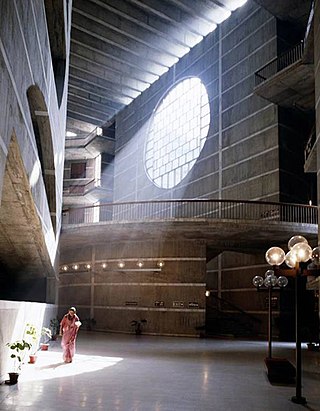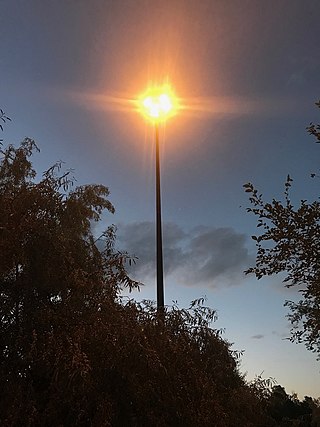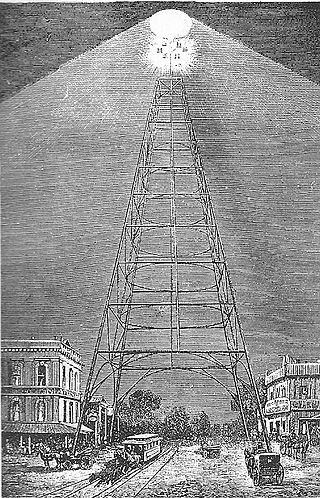
An electric light, lamp, or light bulb is an electrical component that produces light. It is the most common form of artificial lighting. Lamps usually have a base made of ceramic, metal, glass, or plastic, which secures the lamp in the socket of a light fixture, which is often called a "lamp" as well. The electrical connection to the socket may be made with a screw-thread base, two metal pins, two metal caps or a bayonet mount.

An incandescent light bulb, incandescent lamp or incandescent light globe is an electric light with a filament that is heated until it glows. The filament is enclosed in a glass bulb that is either evacuated or filled with inert gas to protect the filament from oxidation. Electric current is supplied to the filament by terminals or wires embedded in the glass. A bulb socket provides mechanical support and electrical connections.

Artificial lighting technology began to be developed tens of thousands of years ago and continues to be refined in the present day.

An arc lamp or arc light is a lamp that produces light by an electric arc.

A fluorescent lamp, or fluorescent tube, is a low-pressure mercury-vapor gas-discharge lamp that uses fluorescence to produce visible light. An electric current in the gas excites mercury vapor, which produces short-wave ultraviolet light that then causes a phosphor coating on the inside of the lamp to glow. A fluorescent lamp converts electrical energy into useful light much more efficiently than an incandescent lamp, but is less efficient than most LED lamps. The typical luminous efficacy of fluorescent lighting systems is 50–100 lumens per watt, several times the efficacy of incandescent bulbs with comparable light output. For comparison, the luminous efficiency of an incandescent bulb may only be 16 lumens per watt.

A sodium-vapor lamp is a gas-discharge lamp that uses sodium in an excited state to produce light at a characteristic wavelength near 589 nm.

A street light, light pole, lamp pole, lamppost, street lamp, light standard, or lamp standard is a raised source of light on the edge of a road or path. Similar lights may be found on a railway platform. When urban electric power distribution became ubiquitous in developed countries in the 20th century, lights for urban streets followed, or sometimes led.

Christmas lights are lights often used for decoration in celebration of Christmas, often on display throughout the Christmas season including Advent and Christmastide. The custom goes back to when Christmas trees were decorated with candles, which symbolized Christ being the light of the world. The Christmas trees were brought by Christians into their homes in early modern Germany.

The history of street lighting in the United States is closely linked to the urbanization of America. Artificial illumination has stimulated commercial activity at night, and has been tied to the country's economic development, including major innovations in transportation, particularly the growth in automobile use. In the two and a half centuries before LED lighting emerged as the new "gold standard", cities and towns across America relied on oil, coal gas, carbon arc, incandescent, and high-intensity gas discharge lamps for street lighting.

Architectural lighting design is a field of work or study that is concerned with the design of lighting systems within the built environment, both interior and exterior. It can include manipulation and design of both daylight and electric light or both, to serve human needs.

Charles Francis Brush was an American engineer, inventor, entrepreneur, and philanthropist.

Gas-discharge lamps are a family of artificial light sources that generate light by sending an electric discharge through an ionized gas, a plasma.

A light fixture, light fitting, or luminaire is an electrical lighting device containing one or more light sources, such as lamps, and all the accessory components required for its operation to provide illumination to the environment. All light fixtures have a fixture body and one or more lamps. The lamps may be in sockets for easy replacement—or, in the case of some LED fixtures, hard-wired in place.

Aviation obstruction lighting is used to enhance the visibility of structures or fixed obstacles which may conflict with the safe navigation of aircraft. Obstruction lighting is commonly installed on towers, buildings, and even fences located in areas where aircraft may be operating at low altitudes. In certain areas, some aviation regulators mandate the installation, operation, color, and/or status notification of obstruction lighting. For maximum visibility and collision-avoidance, these lighting systems commonly employ one or more high-intensity strobe or LED devices which can be seen by pilots from many miles away from the obstruction.

High-mast lighting is a tall pole with lighting attached to the top pointing towards the ground, usually but not always used to light a highway or recreational field. It is used at sites that require lighting over a large area. The pole that the lighting is mounted on is generally at least 30 m (98 ft) tall, while the lighting consists of a luminaire ring surrounding the pole with one or several independent lighting fixtures mounted around it. Most units have four, six or eight lights in the ring, with three, five, ten, twelve and sixteen lights used in rarer instances. While most high-mast lights are high-pressure sodium, other lamp types such as mercury vapor, metal halide and LED, have also been used. Some units have the lighting surrounded by a circular shield to prevent or reduce light pollution or light trespass from affecting neighborhoods adjacent to the highway. Maintenance of these systems is done by lowering the luminaire ring from the mast head to the base using a winch and motor to the ground or at a height accessible by a cherry picker and located in areas to allow for easier access without disrupting traffic.

The Zilker Holiday Tree is a 155 foot Christmas tree made from lights draped from a moonlight tower located in Zilker Park. During the Christmas season the tree is lit by over 3000 colored lights. The lighting of the tree has been an annual tradition in Austin since 1967. On December 26, 2010, a five-kilometer run named after the tree took place.

Walter D'Arcy Ryan was an influential early lighting engineer who worked for General Electric as director of its Illuminating Engineering Laboratory. He pioneered skyscraper illumination, designed the Scintillator colored searchlights display, and was responsible for the lighting of the Panama–Pacific International Exposition in San Francisco and the Century of Progress Exposition in Chicago, in addition to the first complete illumination of Niagara Falls. He combined illumination into both an art and a science.

The moonlight towers in Austin, Texas, are the only known surviving moonlight towers in the world. They are 165 feet (50 m) tall and have a 15-foot (4.6 m) foundation. A single tower casts light from six carbon arc lamps, illuminating a 1,500-foot-radius (460 m) circle brightly enough to read a watch.
The Electro-Dynamic Light Company of New York was a lighting and electrical distribution company organized in 1878. The company held the patents for the first practical incandescent electric lamp and electrical distribution system of incandescent electric lighting. They also held a patent for an electric meter to measure the amount of electricity used. The inventions were those of Albon Man and William E. Sawyer. They gave the patent rights to the company, which they had formed with a group of businessmen. It was the first company in the world formally established to provided electric lighting and was the first company organized specifically to manufacture and sell incandescent electric light bulbs.

The San Jose electric light tower, also known as Owen's Electric Tower after its creator and chief booster, was constructed in 1881 at an intersection in downtown San Jose, California, as a "high light" or moonlight tower to light the city using arc lights. A pioneer use of electricity for municipal lighting, it was later strung with incandescent bulbs and was destroyed in a storm in December 1915. A half-size replica stands at History Park at Kelley Park.






















